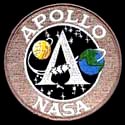The Apollo Program
1963 - 1972

The primary goal of the Apollo program was to land humans on the Moon and bring them back safely to Earth. Six of the missions achieved this goal. Two Apollo missions were Earth orbiting missions to test the Command and Lunar Modules. Two other missions tested various components while orbiting the Moon, they also photo-graphed the lunar surface for possible landing sites. One mission, Apollo 13, suffered an explosion of an oxygen tank and was unable to land on the Moon. There were four Skylab missions and in 1975 the Apollo program ended with the Apollo-Soyuz Test Project (ASTP). The total funding of the Apollo program was approximately $20,443,600,000.
The six missions that landed on the Moon, and returned with a wealth of scientific data and almost 400 kilograms of lunar rock and soil samples, also gave us the only humans to have set foot on another body of our solar system. These Astronauts, 2 from each mission, are: Neil Armstrong, Edwin Aldrin, Charles Conrad, Alan Bean, Alan Shepard, Edgar Mitchell, David Scott, James Irwin, John Young, Charles Duke, Gene Cernan, and Harrison Schmitt. Following is a brief description of the various manned Apollo missions.
|

 Photo by Nasa
Photo by Nasa
